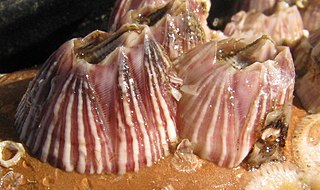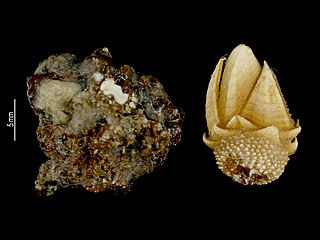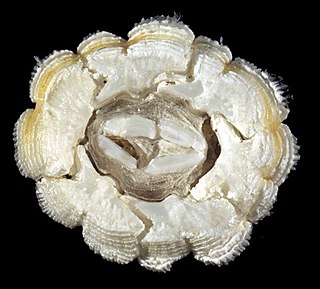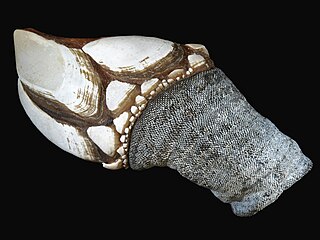 W
WAcasta is a genus of barnacles in the family Archaeobalanidae, containing the following species:
 W
WAmphibalanus is a genus of barnacle of the family Balanidae that includes species formerly assigned to Balanus. It contains the following species:Amphibalanus amphitrite (Darwin, 1854) †Amphibalanus caboblanquensis (Weisbord, 1966) (extinct) †Amphibalanus caribensis (Weisbord, 1966) (extinct) Amphibalanus cirratus (Darwin, 1854) Amphibalanus eburneus (Gould, 1841) †Amphibalanus halosydne (Zullo & Katuna, 1992) (extinct) †Amphibalanus hopkinsi (Zullo, 1968) (extinct) Amphibalanus improvisus (Darwin, 1854) Amphibalanus inexpectatus (Pilsbry, 1916) Amphibalanus peruvianus (Pilsbry, 1909) †Amphibalanus playagrandensis (Weisbord, 1966) (extinct) Amphibalanus poecilotheca (Kruger, 1911) †Amphibalanus reflexus (Zullo, 1984) (extinct) Amphibalanus reticulatus (Utinomi, 1967) Amphibalanus rhizophorae (Ren & Liu, 1989) Amphibalanus salaami (Nilsson-Cantell, 1932) Amphibalanus subalbidus (Henry, 1973) Amphibalanus thailandicus (Puspasari, Yamaguchi & Angsupanich, 2001) Amphibalanus variegatus (Darwin, 1854) Amphibalanus venustus (Darwin, 1854) Amphibalanus zhujiangensis (Ren, 1989)
 W
WThe Archaeobalanidae are a family of barnacles of the order Sessilia.
 W
WArmillifer is a genus of Pentastomida, containing the following species:Armillifer agkistrodontis Self & Kuntz, 1966 Armillifer armillatus Wyman, 1848 Armillifer grandis Hett, 1915 Armillifer mazzai (Sambon, 1932) Armillifer moniliformis (Diesing, 1835)
 W
WArmillifer armillatus is a species of the genus Armillifer occurring in tropical Africa. Its typical definitive hosts are pythons, such as the African rock python, while rodents are presumed to act as intermediate hosts. Humans may become accidentally infected by the eggs particularly if consuming infected snakes. Ingested eggs develop into nymphs that invade different visceral organs causing a disease called porocephalosis. Most human infections are asymptomatic, some are debilitating, or rarely even lethal.
 W
WArmillifer grandis is a species of the pentastomid genus Armillifer distributed in tropical Central and West Africa. Its typical definitive hosts are viperid snakes, while rodents are presumed to act as intermediate hosts. Humans may become accidentally infected by the eggs, particularly if consuming infected snakes. Ingested eggs develop into nymphs that invade different visceral organs, causing a disease that is often called porocephalosis. Most human infections are asymptomatic, some are debilitating, or rarely even lethal. Abdominal infections are more widespread, but typically undiagnosed, while ocular manifestations are rare and may cause blindness.
 W
WAustromegabalanus is a genus of giant barnacles. It contains both extant and extinct species.
 W
WThe Balanidae comprise a family of barnacles of the order Sessilia, containing these genera:
 W
WThe Balanomorpha are a suborder of barnacles, containing familiar acorn barnacles of the seashore. The suborder contains these families:Archaeobalanidae Newman & Ross, 1976 Balanidae Leach, 1817 Bathylasmatidae Newman & Ross, 1971 Catophragmidae Utinomi, 1968 Chelonibiidae Pilsbry, 1916 Chionelasmatidae Buckeridge, 1983 Chthamalidae Darwin, 1854 Coronulidae Leach, 1817 Pachylasmatidae Utinomi, 1968 Platylepadidae Newman & Ross, 1976 Pyrgomatidae Gray, 1825 Tetraclitidae Gruvel, 1903
 W
WBalanus is a genus of barnacles in the family Balanidae of the subphylum Crustacea.
 W
WAcorn barnacles are one of the most common barnacle species on the Pacific coast of North America, distributed from the U.S. state of Alaska to Bahía de San Quintín near San Quintín, Baja California. They are commonly found in the upper intertidal zone on mussels, rocks and pier pilings. They can obtain oxygen from both water and air.
 W
WBalanus nubilus, commonly called the giant acorn barnacle, is the world's largest barnacle, reaching a diameter of 15 cm (6 in) and a height of up to 30 cm (12 in), and containing the largest known muscle fibres.
 W
WBalanus trigonus is a species of barnacle in the family Balanidae. It is steep-sided, conical barnacle, has six shell plates and is pink in colour. They are opportunistic fouling organisms that are endemic to the Indo-Pacific region.
 W
WBranchiura is a group of crustaceans ranked as a subclass of Maxillopoda. They were once thought to be Copepods before becoming their own distinct subclass. Branchiurans are commonly known as fish louse or fish lice if plural. Branchiurans are ectoparasites that are found primarily on fish, but can also be found on other aquatic organisms such as invertebrates and amphibians. Some species feed on the blood of their host, while others feed on mucus and extracellular material. Typically the parasites wait two to three weeks before feeding again.
 W
WCalanticidae is a family of barnacles in the order Pedunculata, containing the following genera:Aurivillialepas Newman, 1980 Calantica Gray, 1825 Crosnieriella Jones, 1998 Euscalpellum Hoek, 1907 Gruvelialepas Newman, 1980 Paracalantica Utinomi, 1949 Smilium Gray, 1825 Scillaelepas Seguenza, 1876
 W
WThe Chthamaloidea are a subdivision of Balanomorpha proposed by Newman and Ross to include barnacles with shell wall composed of rostrum, carina, and one to three pairs of latera, rarely supplemented with one or more whorls of basal imbricating plates. The rostrolatus enters the sheath, but rarely fuses with the rostrum, as in the three higher superfamilies. Shell plates are simple in construction, solid, and incorporate organic chitin between carbonate layers. Opercular plates are deeply interlocked, and in some genera, may become concrescent with age. Soft part morphology includes concave labrum without notch in the central part. Cirrus III more resembles Cirrus IV than II, or may be intermediate in structure. Caudal appendages present in some species.
 W
WChthamalus is a genus of barnacles that is found along almost all non-boreal coasts of the northern hemisphere, as well as many regions in the southern hemisphere. These small barnacles have been studied in part because of the taxonomic confusion over a group of species that, by and large, are morphologically and ecologically quite similar. In recent years, molecular techniques have identified a number of cryptic species that have been subsequently confirmed by taxonomists using morphological measurements. Most recently the genus has been shown to be paraphyletic, with the genus Microeuraphia nested within Chthamalus.
 W
WChthamalus antennatus, the six-plated barnacle is a species of intertidal barnacle found in eastern and southern Australia. Growing from two centimetres wide and one centimetre high. The barnacle is found on the coast, usually on rocks at or above the high tide level or just below the splash zone. Feeding occurs only at unusually high tides.
 W
WChthamalus fragilis is a small gray barnacle found in the upper intertidal zone of the northwestern Atlantic Ocean, from approximately Cape Cod southward to Florida and into the Caribbean and Gulf of Mexico. It is also commonly known as little grey barnacle. The species is believed to have been distributed only as far northward as North Carolina or Virginia until the late 1800s, when it was noticed along the Massachusetts coast. The species may have expanded its range naturally or been introduced to New England through anthropogenic activities. Chthamalus fragilis is unusual in that it often recruits to stems of Spartina alterniflora.
 W
WChthamalus montagui, common name Montagu's stellate barnacle, is a species of acorn barnacle common on rocky shores in South West England, Ireland, and Southern Europe.
 W
WClistosaccidae is a family of parasitic barnacles belonging to the bizarre and highly apomorphic superorder Rhizocephala, which is part of the more diverse of the two orders, the Akentrogonida.
 W
WConcavus is a genus of barnacles.
 W
WElminius is a genus of barnacles in the family Austrobalanidae, containing these species:Elminius kingii Gray, 1831 Elminius cristallinus Gruvel, 1907
 W
WFistulobalanus is a genus of barnacles, comprising the following species:Fistulobalanus abeli (Lami & André, 1932) Fistulobalanus albicostatus (Pilsbry, 1916) Fistulobalanus amaraquaticus (Yamaguchi, 1980) Fistulobalanus citerosum (Henry, 1973) Fistulobalanus dentivarians (Henry, 1973) †Fistulobalanus klemmi Zullo, 1984 Fistulobalanus kondakovi (Tarasov & Zevina, 1957) Fistulobalanus pallidus (Darwin, 1854) Fistulobalanus patelliformis (Bruguière, 1789) Fistulobalanus shiloensis (Pilsbry, 1930) Fistulobalanus sumbawaensis Prabowo & Yamaguchi, 2005 Fistulobalanus suturaltus (Henry, 1973)
 W
WFistulobalanus albicostatus is a species of barnacle in the family Balanidae.
 W
WHeterosaccus is a genus of barnacles in superorder Rhizocephala. Like other taxa in this superorder, they parasitize crabs. Geoffroy Smith circumscribed the genus in 1906; he initially only included H. hians. Smith circumscribed a genus distinct from Sacculina due to a difference of the mesentery; in Heterosaccus, the mesentery does not stretch down to the mantle opening but rather only is present on the ring of attachment.
 W
WLepadidae is a family of goose barnacles, erected by Charles Darwin in 1852. It contains the three genera Lepas, Conchoderma and Dosima.
 W
WLepas is a genus of goose barnacles in the family Lepadidae.
 W
WNotochthamalus scabrosus, the only species in the genus Notochthamalus, is a species of barnacle found along the south-western and south-eastern coasts of South America, from Peru to the Falkland Islands. The species is found almost exclusively higher in the intertidal zone than the mussel Perumytilus, often codistributed with the confamilial barnacle Chthamalus cirratus and Balanus flosculus.
 W
WThe Platylepadidae are a family of barnacles of the order Sessilia.
 W
WPlatylepas is a genus of barnacles in the family Platylepadidae of the subphylum Crustacea.
 W
WPoecilasmatidae is a family of goose barnacles.
 W
WPollicipedidae is a family of goose barnacles.
 W
WPollicipes is a genus of goose barnacles, first described by William Elford Leach in 1817. It comprises four species of marine suspension-feeders.
 W
WThe Sacculinidae are a family of barnacles belonging to the bizarre parasitic and highly apomorphic superorder Rhizocephala, and therein to the less diverse of the two orders, the Kentrogonida. The Sacculinidae are one of the two larger families of Rhizocephala, containing seven genera:Drepanorchis Boschma, 1927 Heterosaccus Smith, 1906 Loxothylacus Boschma, 1928 Polyascus Glenner, Lützen & Takahashi, 2003 Ptychascus Boschma, 1933 Sacculina Thompson, 1836 Sesarmaxenos Annandale, 1911
 W
WSemibalanus is a genus of barnacles, comprising two species. It is the only genus in the subfamily Semibalaninae.
 W
WSessilia is an order of barnacles, comprising the barnacles without stalks, or acorn barnacles. They form a monophyletic group and are probably derived from stalked barnacles. The order is divided into three suborders. The Brachylepadomorpha contain a single family, Neobrachylepadidae, while the Verrucomorpha contain two families, Verrucidae and Neoverrucidae. The remaining 12 families are in the suborder Balanomorpha.